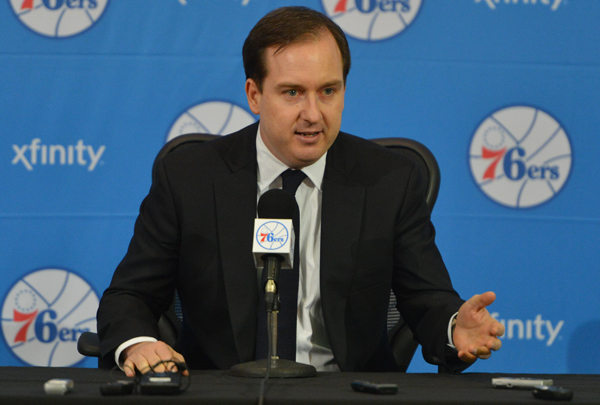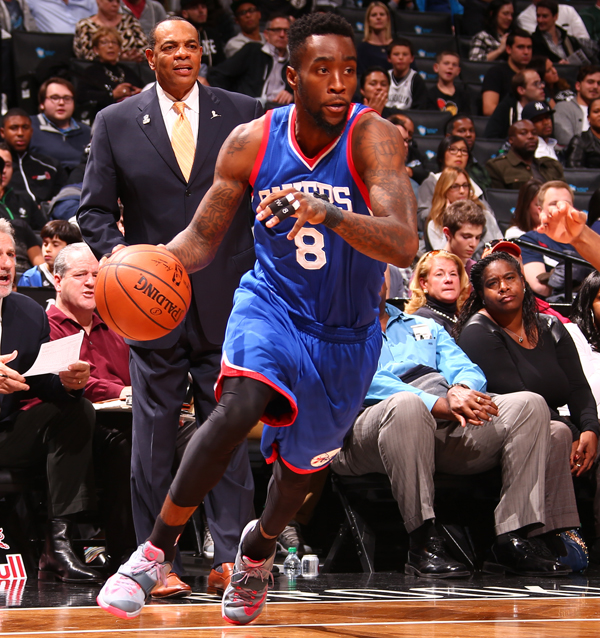On May 26, 2012, the Philadelphia 76ers sparred with the Celtics in Game 7 of the second round of the Playoffs. The game itself ultimately exposed the Sixers as pretenders, but still, they made it to the Elite 8. They were a young team full of holes with maybe a chance to make a name in the coming years if certain things broke their way. They had upside, if nothing else.
That was only two and a half years ago and yet it already seems like a dream. The current incarnation is years away from even sniffing another Game 7. They’ve become team non grata, a living manifestation of the NBA’s failures to figure things out.
In October, the NBA board of governors voted on Draft reform. Shockingly the reform vote failed to reach the number of votes required to initiate change. For an issue that has recently, angrily bubbled up to the surface, reform failure disappointed many around the League. A reform in the Draft process would eliminate tanking—the process in which teams willfully lose games in hopes of landing a better Draft position and thus the possibility of ending up with the next Kevin Durant. Proper rebuilding takes a long time, but tanking (in theory, anyway) allows teams to push the fast-forward button. However, purposeful losing doesn’t play well for public relations purposes. It’s looked down upon by most fans, players and certainly the media as a punk-ass way of doing business. The current Sixers however, show no shame in what they’re doing.
It’s likely that those who are anti-tanking have elevated feelings toward Sixers GM Sam Hinkie and his devotion to advanced analytics. A system based more on numerical equations over the legacy-tested grit of in-person scouting and gut evaluations, advanced analytics made its name in Major League Baseball, most notably by A’s GM Billy Beane, who used this system to sneak low payroll teams devoid of stars into numerous post-season berths. Not to mention, getting Brad Pitt to play him in a movie. Maybe Hinkie wants the Hollywood treatment, too.
Hinkie, who previously served as the Rockets’ assistant GM under Daryl Morey, is stacking high Draft picks, or as he calls them, “assets,” in order to maneuver changes to his now-feeble roster.
“If I lived in Philly I don’t know if I’d buy season tickets,” says Michele Roberts, head of the NBA player’s union. “Players aren’t happy with what the Sixers are doing and at the end of the day, the Philadelphia fans watching the team play have the right to see a competitive sport. You’ve created a system which encourages that team to lose consistently. Well, how many [fans] have you already lost with people thinking that the team is going to lose? Players want to win, and it’s something that we have to address.”

The franchise is now serving as a flesh-eating bacteria of sorts on the NBA’s collective self-respect. As they lose more games and people outside of sports begin to understand what’s happening, there’s potential here to discredit the entire League. Publicly, the company line is vigorous. The Sixers are tanking, but they won’t dare utter it out loud, especially not to SLAM.
Honestly, the silence is smart, since it’s not like the team can promote a catchphrase like “Just Lose, Baby” or anything. But it’s obvious what’s going on. Philadelphia Inquirer sportswriter John Mitchell, who worked the Sixers beat when Hinkie first arrived, puts it this way: “They place so much on getting Draft picks, but who is to say that the players are going to be good? Michael Carter-Williams, I mean I know it’s only been one year, but he doesn’t look like a superstar. Then you have a 6-11, 211-pound power forward. What’s Plan B if all this stuff doesn’t work?”
Sixers’ legend Billy “Kangaroo Kid” Cunningham is one of the few big names who have come out in support of the current regime’s plan. Others haven’t been as kind. Philly sports radio giant Howard Eskin has repeatedly waged war against the team’s front office, even taking to social media to label Sixers CEO Scott O’Neil a “puppet.”
Current SMU coach Larry Brown, who teamed with Allen Iverson to lead the Sixers to their last Finals appearance back in 2001, recently answered a question about the Sixers by essentially saying their whole program is fraudulent. “These analytics, they don’t mean squat to me,” Brown said. “To say that these analytics guys have the answer is crazy. It doesn’t apply to basketball. Everybody uses the data you get, but that’s what coaching is. Maybe it will work, I don’t know. But it’s a shame what those fans are going through waiting to see if it will.”
The fan base, incredibly enough, seems to be on the side of the team. Their reputation for being crazed fans is a bit more fiction than reality, but Philly folks do take their sports very seriously. They want results, point blank. The fact that the city hasn’t completely turned on the franchise, which finally beat the Timberwolves the first week of December after losing its first 17 games of the season, is the most surprising thing of all. It does prove one thing, however—that Hinkie is a hustler.
He’s no different than politicians who spin terms like family values and trickle-down economics. People know in their guts that it doesn’t make sense, that the things being discussed don’t correlate with intelligent thinking. They sign up anyway. Sixer fans know the Earth isn’t flat, but they’re looking for a unicorn to give their dreams meaning. So they’ve committed to losing games and investing in a five-year plan with no track record of success. Sam Hinkie sees the desperation in their eyes and is probably toasting to it right now.
“Believe it or not, people really believe in what Hinkie’s doing because he has a plan,” says Keith Pompey, who currently works the Sixers beat for the Inquirer. “Long term, they believe it will bring a title to Philly. If they win 15 games this year and finish with the worst record, a lot of fans are still going to be happy because they’ll get the No. 1 pick. The team has been very transparent—people are expecting them to lose. The average fan is all for it and Hinkie’s approval is probably the highest in Sixer history.”
Through a 7-30 start, the team has played hard through blowouts and nail-biters alike, and there hasn’t been any public bickering yet. That’s a credit to coach Brett Brown, who promised to coach ’em up and lead this team. Brown, who came to Philadelphia before last season after 11 seasons on Greg Popovich’s staff, is somehow both a realist and a dreamer. It’s hard to gauge his coaching ability with such a thin roster, but he seems to have a grasp on the mission ahead of him.
“They understand reality and they understand what we face,” the Sixers coach says. “But they believe that we can get good at things if you choose to pay attention. We hope to pay attention to development and sports science and everything I said when I took this position. It’s going to be a long year and we’re going to develop our young guys as much as possible.”
We may look back at the 2014 NBA Draft as the fulcrum that will define success or failure for this grand experiment. In what was considered a strong draft, the Sixers had two picks in the top 10. With a roster thirsty for NBA-level players, the Sixers brain trust selected Kansas big man Joel Embiid and Croatian prospect Dario Saric, respectively. Though Embiid may miss the entire season, it’s hard to fault the team for taking a chance on such a talented big man. And in the months he’s been on the team, even injured, Embiid has become somewhat of a social media star, which fans love.
The Saric selection, however, seemed terrible in June and even worse now. Not only is Saric unavailable this season (he’s contractually obligated to his team in Turkey), but there’s no guarantee he’ll be here next year, either. Truth is, like some Euro players, he may decide that American life isn’t for him and never come at all. To say it was a reckless and arrogant pick doesn’t even begin to take into account the players on the roster right now, who would benefit from an infusion of talent.

Right now the roster is a motley crew of players filling roster spots until better players come in. It’s as anonymous a squad as there’s been in recent memory. Hell, the Sixers team website couldn’t even name the players on its own team, accidentally posting a roster picture with long-retired forward Bo Outlaw to start the season. Last year’s ROY Carter-Williams started the season injured, so the team relied on third-year guard Tony Wroten. Wroten is quick and has a flair for the dramatic offensively, making him unique in this sorry lineup. His 16.9 ppg and 5.2 apg keep the Sixers from being out of many games by halftime.
Other names, like rookie KJ McDaniels, have also raised eyebrows. McDaniels, who has shown a lot of ability on the defensive end, is probably the Sixers’ best perimeter defender and has a knack for being around the ball. Players such as Henry Sims and Hollis Thompson do their best to contribute. The point is, the fridge is not completely bare here, but reviewing the roster leads to more conversations centered around “Who is that?” or “I remember him, he had a good game in the ACC tourney last year”-type comments than any other current NBA team.
Philly’s 2013 Lottery pick, Nerlens Noel, has shown the kind of otherworldly defensive instincts he displayed at Kentucky, which, considering his injury, is a bright spot. The coaches are also high on forward JaKarr Sampson, whom Brown mentions a lot in regards to “complementary guys (we’ll) build around our Lottery picks.”
And yet: Last season, the Sixers succumbed to a 26-game losing streak and on paper they’re a worse team now. This year will likely test the patience of fans like no time in recent history. How long will they have to wait before their faith is rewarded? The NBA has already turned on the Sixers; how long before the fans follow?
Khalid Salaam is a Senior Writer at SLAM. Follow him on Twitter @MrKhalidS.
images via Getty/NBAE